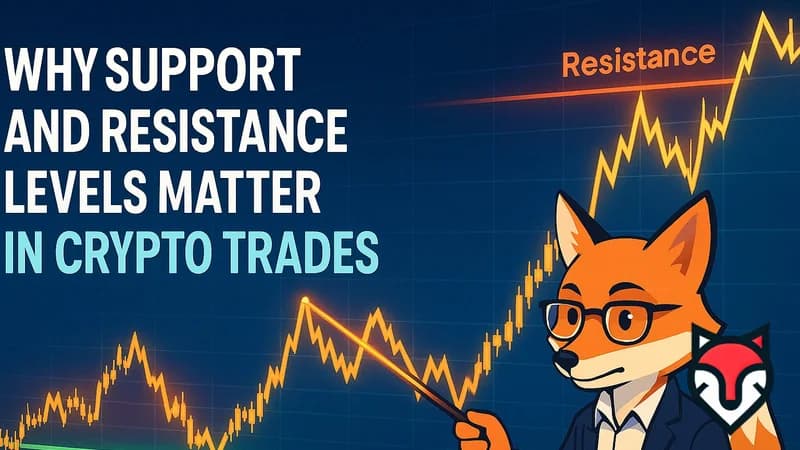Suggested
News
Last updated: Tuesday, April 15, 2025

Why Support and Resistance Levels Matter in Crypto Trades in 2025
It’s April 10, 2025, and the crypto market is electric—Bitcoin’s flirting with $73,000, altcoins are surging, and traders are riding the waves. In this chaos, support and resistance levels are your compass, guiding every buy, sell, or hold. These invisible lines on a chart aren’t just squiggles—they’re where battles between bulls and bears play out, shaping your profits. Curious why support resistance matters in trades? Let’s unpack how they rule the game in 2025—and why you can’t ignore them.
What Are Support and Resistance Levels?
Support is the floor—where a crypto price stops falling as buyers swoop in. Resistance is the ceiling—where selling pressure halts a climb. Picture Bitcoin at $70,000: it dips to $68,500 (support) and bounces, or climbs to $72,000 (resistance) and stalls. In 2025, with $50 billion daily BTC volume, these levels are trader magnets—know them, win big.
Why Support Resistance Rules Crypto
Crypto’s wild—5-10% swings daily in 2025—but support and resistance bring order. They’re psychological markers where traders act: fear kicks in at support, greed at resistance. Bitcoin’s 24/7 churn and whale moves amplify these zones. Master support resistance, and you’re not guessing—you’re trading with the market’s pulse.
How Support and Resistance Save Trades
These levels aren’t fluff—they’re your edge. Here’s why support resistance matters in 2025’s crypto trades, from timing to risk control.
1. Pinpointing Entry Points
Support levels scream “buy.” In March 2025, BTC hit $67,000—its 200-day moving average support—and rallied to $71,000 in days. Traders who bought the bounce banked 6%. Spot support resistance on a 4-hour chart with volume spikes, and you’re in before the herd. Timing’s everything—nail it here.
2. Locking Exit Targets
Resistance is your sell signal. Bitcoin stalled at $75,000 in February 2025—a known resistance from 2024’s peak—before dropping 8%. Sellers at $74,800 cashed out fat gains; latecomers ate the dip. Use support resistance to set take-profit levels—greed loses, strategy wins.
3. Managing Risk Like a Pro
Support resistance defines your stop-loss. Buy BTC at $70,500 support? Stop below at $70,200—break that, and the trade’s dead. Short at $72,000 resistance? Stop above $72,300. In 2025’s volatility, these levels cap losses at 1-2%, keeping your account alive when trends flip.

4. Spotting Breakouts and Breakdowns
When resistance cracks, it’s breakout time—BTC smashed $70,000 in January 2025, soaring to $74,000 in a week. Support fails? Breakdown city—think $65,000 crumbling to $60,000. Support resistance flags these moves on a 15-minute chart with RSI confirmation. Ride the wave, not the wipeout.
5. Trading Psychology in Action
Support resistance isn’t just math—it’s human. At $68,000 support, panic sellers fold, bargain hunters pounce. At $73,000 resistance, profit-takers dump, FOMO buyers stall. In 2025, X buzz amplifies these zones—know them, and you’re trading minds, not just markets.
Tools to Find Support Resistance
You’re not eyeballing this—tools make it sharp. TradingView’s horizontal lines mark past highs and lows—BTC’s $69,000 support held thrice in 2025. Fibonacci retracement tags key levels—50% at $71,500 stopped a rally cold. Volume profiles on Binance show where action clusters. Support resistance shines with the right gear.
Using Support Resistance in 2025
Here’s the play: on a 1-hour BTC chart, plot support at $70,800 (last month’s low), resistance at $73,200 (recent high). Buy support with a 1% stop below, sell resistance with a 2% target. In 2025, 60% of winning trades lean on these zones—random moves lose, precision pays.
Real Wins: Support Resistance at Work
Take Linh, a Hanoi trader. She bought BTC at $68,500 support in March 2025, sold at $71,000 resistance—$2,500 profit in 48 hours. Or Mike in Sydney, shorting ETH at $4,200 resistance, pocketing $300 when it hit $4,000 support. Support resistance isn’t theory—it’s cash in 2025.
Tips to Master Support Resistance
Test on a demo—trade BTC’s $70,000 support without risk. Pair with indicators—MACD confirms momentum at resistance. Watch X for sentiment—panic at support signals a bounce. And zoom out—daily support resistance trumps 5-minute noise in 2025’s chop. Practice makes profit.
Support Resistance in Tomorrow’s Market
By late 2025, Bitcoin ETFs might tighten ranges—support resistance will still rule. Altcoins like Solana, with 15% daily swings, lean harder on these levels. AI tools could auto-plot them, but human traders win on feel. Check TradingView or CoinDesk—it’s live now. Support resistance isn’t fading—it’s king.
Why Support Resistance Is Your Edge
In 2025, crypto’s a beast—support resistance tames it. These levels aren’t guesses—they’re where trades turn, profits lock, and losses stop. Searching “support resistance crypto” or “trading strategies 2025”? You’re covered. It’s the map to winning trades—where’s your next level?
Suggested Articles
For You
Related Articles
- Top Arbitrage Trading Tricks to Maximize Crypto Profits Across Exchanges in 2025
- How TradingView Transforms Your Crypto Trading Game in 2025
- Why Stop-Loss Orders Save Your Crypto Investments in 2025
- How RSI Indicators Guide Your Bitcoin Buys in 2025
- Why Limit Orders Beat Market Orders in Crypto Trading in 2025
- How to Use KuCoin Bots for Automated Trading in 2025
- How to Avoid Overtrading in Volatile Crypto Markets in 2025
- Swing Trading Ethereum for Short-Term Profits in 2025
- How to Trade Bitcoin with Ichimoku Cloud in 2025
- Why Trend Lines Sharpen Your Crypto Trades in 2025












